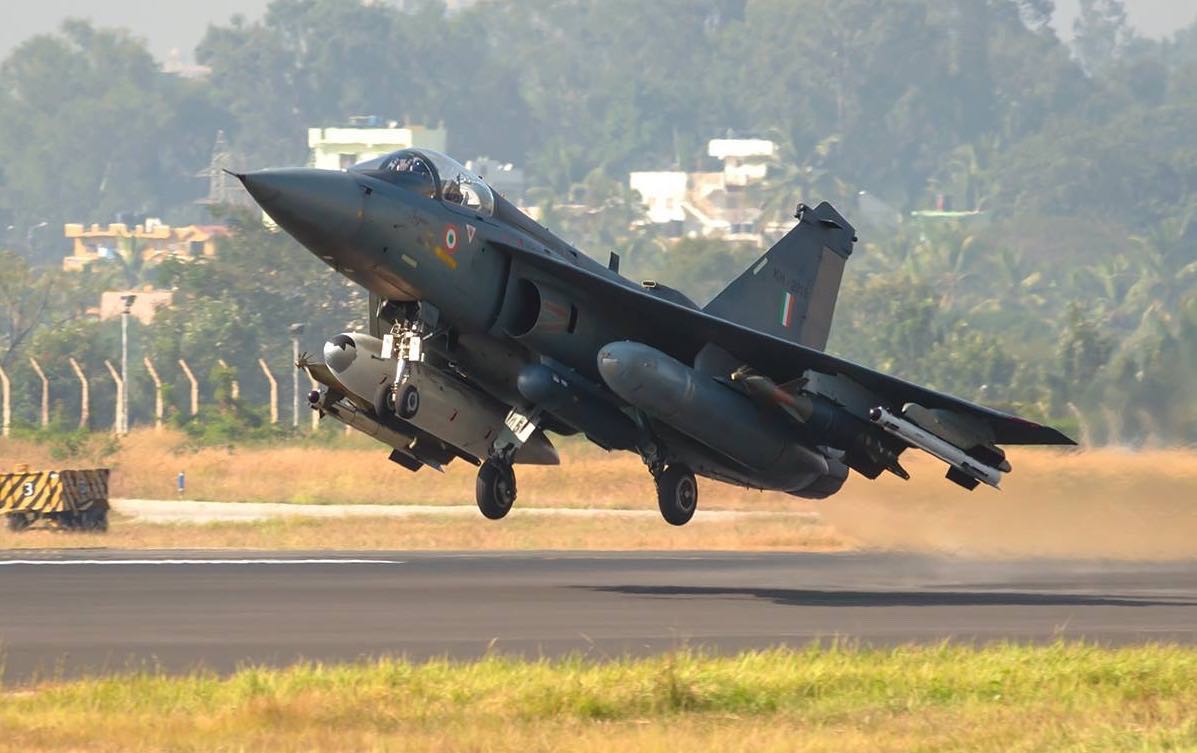Tejas
February 16, 2017 | Expert Insights
On 14 Feb 2017, the 11th Edition of Aero India commenced at Bangalore, with the participation from 30 countries and as many as 72 state-of-the-art aircraft. Amongst the indigenous products on display is Tejas, the single-seater, single-engine, multi-role light fighter developed by the HAL, for the Indian Air Force (IAF) and Indian Navy (IN). The aircraft has a top-speed of 2,205 Km per hour, a production cost of US$ 31 million per unit and is powered by the General Electric F404 Turbofan engine.
How Long has the Prototype been in the Making?
The DRDO’s Light Combat Aircraft (LCA) program was sanctioned in 1983, with the intention of inducting indigenous combat aircraft into the forces, by 1994. However, despite repeated slippages, the government and the armed forces continue to encourage the indigenous-production effort because the alternative is to revert to import dependence.
On 01 July 2016, the IAF commissioned No.45 Squadron: Flying Daggers, the first Indian combat unit to be equipped with the Tejas Fighter. However, the squadron has received only three aircrafts, so far; even though the IAF has pledged to procure 200 single-seater fighters and 20 twin-seater trainers. New Tejas fighter aircraft are expected to be equipped with relaxed static stability, fly-by-wire, multi-mode radar, integrated digital avionics, composite structures and flat-rated engine, amongst other technologies.
The Tejas is powered with the US-imported General Electric F404 engine. Our effort to produce the indigenous Kaveri engine was being undertaken by GTRE (Gas Turbine Research Establishment), Bangalore. However, the project failed to satisfy technical requirements and keep up with time-deadlines. The project has now entered into technical collaboration with Safran, France.
In Dec 2016, the IN rejected the Tejas fighter, as it was too heavy to operate from aircraft carrier platforms. In Feb 2017, the IN floated RFI (Request for Information), for 57 aircraft needed to operate from floating platforms. US Boeing has reportedly offered the F-A/18 Hornet, while Sweden’s Saab has offered the AB Gripen.
Why is there a demand for fighter aircraft?
India has a requirement for 45 fighter squadrons but is now down to only 32 operational squadrons, the lowest in a decade. There is an urgent requirement to replace the obsolete Mig-21, which has been the IAF mainstay, since the 1971 War. The IAF had floated a global tender for 126 MMRCA (Medium Multi-Role Combat Aircraft) and entered into negotiations with Dassault of France, for the Raffaele. However, the contract faced difficulties with liability, quality assurance and transfer of technology issues. US Lockheed Martin had offered to transfer sole production of the F-16 to India, provided the IAF bought at least 100 aircraft to give stability to the Industry. However, that offer has not been renewed after the new President took office; so far, at least.
South Korea and Indonesia plan to jointly develop the twin-engine KF-X fighter jet. Taiwan also plans to build 66 jet-trainers, as a first step towards the manufacture of a combat plane. There are fears that with a more inward-looking US, nations in SE Asia and the Pacific rim may have to become more self-reliant for security.
Assessment
Lockheed Martin’s offer to relocate the F-16 production line to India, may appear attractive. However, even if the Indian Government were to take-up the offer, the new US dispensation could block the proposal, on grounds of job-losses, for Americans. Notwithstanding, even if the manufacturing were actually relocated to India, with high levels of robotics and AI in the modern production line, we should recalculate the employment benefits against the cost of the relocation exercise.
Production of state-of-the-art fighter aircraft is technologically challenging and it may be unrealistic to expect the DRDO to produce a completely indigenous aircraft, from scratch. Perhaps collaborative partnerships like with the Brahmos missile and the Su-30 MKI projects, give us more benefits than downright purchase and relocation of a production facility.
Despite encouragement and time delays many DRDO projects have failed to live up to national aspirations. Would performance improve if the government made the users (IA, IN and IAF) take ownership for some projects? All three services have motivated, capable and technically qualified officers, who could be made Project Directors of selected projects. However instead of providing these officers on deputation, they should remain responsible to respective service HQ, for meeting service aspirations and time-deadlines.


